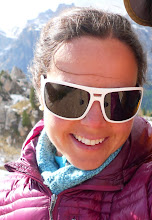The route begins with four ‘approach pitches’ to the business: an insecure and sandy 5.8, a 5.10c with some liebacking through a small roof, a techie 5.11c traverse, and a 5.10d thin flake to face climbing. These pitches spit you out at the infamous ‘Rocker Blocker’, a feature like the Boot Flake on El Cap, the Split Pillar on the Stawamus Chief, and the Harding Slot on Washington Column that exemplify the way climbers have created their own geography and nomenclature for the physical features that have meaning to us. The Rocker Blocker is a completely detached mini-bar sized block that teeters disturbingly on the apex of a blunt tower directly beneath the steep dihedral that comprises the midsection of Moonlight Buttress.
It is at the Rocker Blocker that the free climbing difficulties begin abruptly, with a reachy face climbing sequence and strenuous mantle to sustained finger locks and laybacking. If you are under 5’11” you may want to consider standing on your pack, the rope or a piss-soaked rock poached from behind the Rocker Blocker unless dynoing to sandy crimps is your forte. The next pitch is the technical crux of the route, and unfortunately for the belayer, begins off a steep, hanging stance. Climbers with bigger cajones than me (OK, it’s true, I don’t really have cajones) link the previous pitch into the crux, giving a 180’ super pitch of powerful laybacking with only a few stems and stances for respite. The crux pitch involves steep laybacking up the thin crack through a bulge: big moves between the sausage-finger friendly pinscars, or desperate tips-locks in between, take your pick. Stepping into the bottom of a shallow triangular slot allows a quick shake and a chance for your sweat glands to catch up and really lube things up for the subsequent 10 feet of heinous, flared, graceless groveling. Working out this section left me with some painful raspberries on my biceps and shoulders that several weeks later are still scabby and peeling. At the top of the flare you have to suppress the powerful urge to grab the tat on the three bolt aid climbing anchor and continue up 40’ of 5.11- climbing to the proper free belay under an imposing roof.
Time to pull the roll of tape out of the bullet pack, because from here on up the cruxiest climbing is going to be hard on your fingie skin. Some 5.8 chimneying past a bolt feels pretty reasonable until the chimney opens into a shallow dihedral and once again, it’s all about the laybacking. A long and skinny ledge provides the perfect opportunity for a real rest and a chance to take in the views of the Virgin River winding lazily through stunning rock formations. If you’re lucky like we were, you may even spy a giant California Condor using its 9’ wingspan to surf the updrafts. But don’t get too comfy because the remaining four pitches of the route are still looming overhead. The next section has to be some of the most aesthetic climbing I have ever done. A single finger crack with occasional footholds and shallow corner features splits the dead vertical headwall. The exposure is breathtaking owing to the location of the route on a steep buttress underlain by a roof. Three pitches of tight to rattly finger locks and occasional jugs brings you to the last pitch, where in typical sandstone style, the rock quality begins to deteriorate due to weathering. A few sandy slab moves lead to the summit mantle and a gnarly pine belay.
I first climbed Moonlight Buttress two years ago and performed terribly. My husband Evan ended up leading most of the hard pitches and I spent the whole day feeling intimidated and unworthy of such a route. However, as with most climbing projects, the seed was planted and I hoped that someday I could come back and climb the route in better style. A road trip in Utah this fall and a chance to climb with a committed, motivated and strong female partner allowed me the opportunity I needed. After spending several days working out the route with Jen Olson, we were left with one day before she had to head back to her job as a mountain guide in Canada. We swapped leads on the route, switching order at the crux so I could lead both the crux and the two big-finger pitches (she has pretty, feminine hands, while I have chubby sausage fingers). I whipped off the crux pitch on my first attempt, but lowered off the aid climbing anchor, cleaned my gear, pulled the rope and successfully lead it on my second go. I had previously sent all the remaining pitches, so had the mental advantage of knowing I was capable of climbing them. I held on tight for the rest of the route and managed to send.
Now I am left with one month of my road trip to go before heading back to Canada for the long and chilly ski season. I can only hope that the rest of the trip can offer some more of the high quality climbing and enjoyable adventures that my time on Moonlight provided.

















